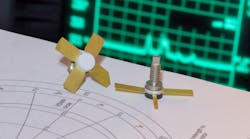Dreamstime_Michel Dreher_65920278
Members Only Content
RF Demystified: The Different Types of Scattering Parameters (Download)
Sept. 14, 2022
Scattering parameters (S-parameters), which describe the fundamental characteristics of RF networks, come in many flavors, including small signal, large signal, pulsed, cold, and mixed mode. They quantify how RF energy propagates through a system and thus contain information about its fundamental characteristics.
Using S-parameters, we can represent even the most complex RF device as a simple N-port network. Figure 1 shows an example of a two-port unbalanced network, which can be used to represent many standard RF components such as RF amplifiers, filters, or attenuators, to name a few.
Comments
Comments
